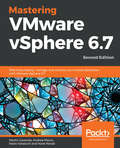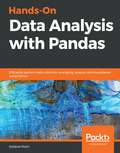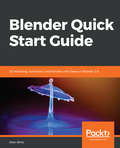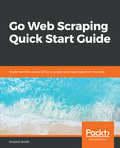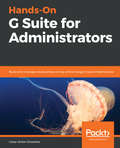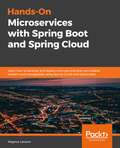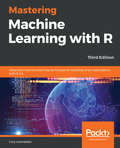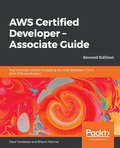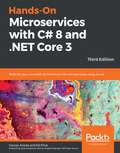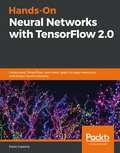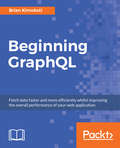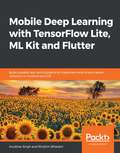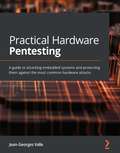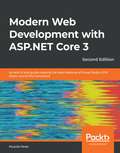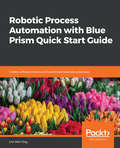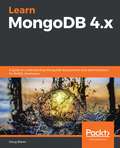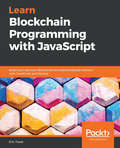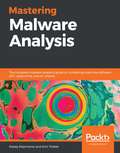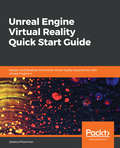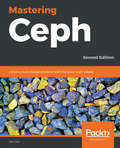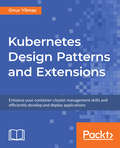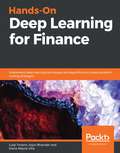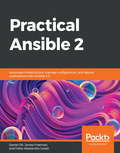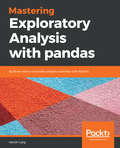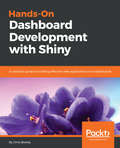- Table View
- List View
Mastering VMware vSphere 6.7 - Second Edition: Effectively deploy, manage, and monitor your virtual datacenter with VMware vSphere 6.7, 2nd Edition
by Martin GavandaIf you are an administrator, infrastructure engineer, IT architect, or an IT consultant and analyst who has basic knowledge of VMware vSphere and now wants to master it, then this book is for you.
Hands-On Data Analysis with Pandas: Efficiently perform data collection, wrangling, analysis, and visualization using Python
by Stefanie MolinGet to grips with pandas—a versatile and high-performance Python library for data manipulation, analysis, and discovery Key Features Perform efficient data analysis and manipulation tasks using pandas Apply pandas to different real-world domains using step-by-step demonstrations Get accustomed to using pandas as an effective data exploration tool Book Description Data analysis has become a necessary skill in a variety of positions where knowing how to work with data and extract insights can generate significant value. Hands-On Data Analysis with Pandas will show you how to analyze your data, get started with machine learning, and work effectively with Python libraries often used for data science, such as pandas, NumPy, matplotlib, seaborn, and scikit-learn. Using real-world datasets, you will learn how to use the powerful pandas library to perform data wrangling to reshape, clean, and aggregate your data. Then, you will learn how to conduct exploratory data analysis by calculating summary statistics and visualizing the data to find patterns. In the concluding chapters, you will explore some applications of anomaly detection, regression, clustering, and classification, using scikit-learn, to make predictions based on past data. By the end of this book, you will be equipped with the skills you need to use pandas to ensure the veracity of your data, visualize it for effective decision-making, and reliably reproduce analyses across multiple datasets. What you will learn Understand how data analysts and scientists gather and analyze data Perform data analysis and data wrangling in Python Combine, group, and aggregate data from multiple sources Create data visualizations with pandas, matplotlib, and seaborn Apply machine learning (ML) algorithms to identify patterns and make predictions Use Python data science libraries to analyze real-world datasets Use pandas to solve common data representation and analysis problems Build Python scripts, modules, and packages for reusable analysis code Who this book is for This book is for data analysts, data science beginners, and Python developers who want to explore each stage of data analysis and scientific computing using a wide range of datasets. You will also find this book useful if you are a data scientist who is looking to implement pandas in machine learning. Working knowledge of Python programming language will be beneficial.
Blender Quick Start Guide: 3D Modeling, Animation, and Render with Eevee in Blender 2.8
by Allan BritoLearn the new Blender 2.8 user interface and make 3D modelsKey FeaturesFind your way round the new user interface and tools of Blender 2.8Create materials, apply textures and render scenesUse the new cutting-edge real-time render EEVEE in your projectsBook DescriptionBlender is open source 3D creation software. With a long history and an enthusiastic community of users, it is the ideal choice for almost any kind of work with 3D modeling or animation. However, for new users, its power and flexibillity can sometimes be daunting, and that’s when you need this book!The book starts by showing you round the all-new Blender 2.8 user interface. You'll look at the most commonly-used options and tools, such as navigating in 3D and selecting objects. You will then use and manipulate one of the most important windows of the interface, the 3D View.You'll learn how to use essential tools for working with 3D modeling. To give your models the feel of real-world objects, you'll learn how to create materials and set up surfaces. You'll see how to use Physically-Based Rendering (PBR), which allows you to craft realistic surfaces such as wood, stone, and metal. You will also work with Eevee, a new real-time render engine in Blender. You will see how to add motion to objects, making use of Blender's impressive 3D animation features. Finally, you'll learn how to create scenes and organize them for rendering, and later add titles and effects using built-in Blender tools.By the end of the book, you will be able to use Blender 2.8 new UI, Create 3D Models with textures, Animations, and Render them in real-time using Eevee.What you will learnManipulate and visualize your 3D objects in BlenderUse polygon modeling tools such as extrude, loop cut, and moreApply precision modeling tools like snapping and the 3D CursorRender a scene using the real-time engine EeveeCreate materials for Eevee and CyclesRender a scene with the Eevee real-time engineUse PBR textures to craft realistic surfaces such as wood with the Shader EditorAdd motion and animation using keyframesCreate animation loops using curves and modifiersWho this book is forThis book is for anyone interested in taking their steps with Blender. If you're an experienced 3D artists or hobbyist, this book will help you with its features.
Go Web Scraping Quick Start Guide: Implement the power of Go to scrape and crawl data from the web
by Vincent SmithLearn how some Go-specific language features help to simplify building web scrapers along with common pitfalls and best practices regarding web scraping. Key Features Use Go libraries like Goquery and Colly to scrape the web Common pitfalls and best practices to effectively scrape and crawl Learn how to scrape using the Go concurrency model Book Description Web scraping is the process of extracting information from the web using various tools that perform scraping and crawling. Go is emerging as the language of choice for scraping using a variety of libraries. This book will quickly explain to you, how to scrape data data from various websites using Go libraries such as Colly and Goquery. The book starts with an introduction to the use cases of building a web scraper and the main features of the Go programming language, along with setting up a Go environment. It then moves on to HTTP requests and responses and talks about how Go handles them. You will also learn about a number of basic web scraping etiquettes. You will be taught how to navigate through a website, using a breadth-first and then a depth-first search, as well as find and follow links. You will get to know about the ways to track history in order to avoid loops and to protect your web scraper using proxies. Finally the book will cover the Go concurrency model, and how to run scrapers in parallel, along with large-scale distributed web scraping. What you will learn Implement Cache-Control to avoid unnecessary network calls Coordinate concurrent scrapers Design a custom, larger-scale scraping system Scrape basic HTML pages with Colly and JavaScript pages with chromedp Discover how to search using the "strings" and "regexp" packages Set up a Go development environment Retrieve information from an HTML document Protect your web scraper from being blocked by using proxies Control web browsers to scrape JavaScript sites Who this book is for Data scientists, and web developers with a basic knowledge of Golang wanting to collect web data and analyze them for effective reporting and visualization.
Hands-On G Suite for Administrators: Build and manage any business on top of the Google Cloud infrastructure
by Cesar Anton DorantesEffectively implement and administer business solutions on any scale in a cost-effective way to have a competitive advantage using Gsuite Key Features Enhance administration with Admin console and Google Apps Script Prepare for the G suite certification using the concepts in the book Learn how to use reports to monitor, troubleshoot and optimize G Suite Book Description Hands-On G Suite for Administrators is a comprehensive hands-on guide to G Suite Administration that will prepare you with all you need to know to become a certified G Suite Administrator, ready to handle all the business scales, from a small office to a large enterprise. You will start by learning the main features, tools, and services from G Suite for Business and then, you will explore all it has to offer and the best practices, so you can make the most out of it. We will explore G Suite tools in depth so you and your team get everything you need -combination of tools, settings and practices- to succeed in an intuitive, safe and collaborative way. While learning G Suite tools you will also learn how to use Google Sites and App Maker, to create from your corporate site to internal tools, live reports that seamlessly integrate with live documents, and advanced Google Services. Finally, you will learn how to set up, analyze and enforce Security, Privacy for your business and how to efficiently troubleshoot a wide variety of issues. What you will learn Setting up G Suite for the business account Work with the advanced setup of additional business domains and administrate users in multiple Explore Guite's extensive set of features to cover your team's creation and collaboration needs Setup, manage and analyze your security to prevent, find or fix any security problem in G Suite Manage Mobile devices and integrate with third-party apps Create cloud documents, working alone or collaborating in real time Who this book is for System administrators, cloud administrators, business professionals, and aspirants of G Suite admin certificate wanting to master implementing G Suite tools for various admin tasks and effectively implement the G Suite administration for business
Hands-On Microservices with Spring Boot and Spring Cloud: Build and deploy Java microservices using Spring Cloud, Istio, and Kubernetes
by Magnus LarssonApply microservices patterns to build resilient and scalable distributed systems Key Features Understand the challenges of building large-scale microservice landscapes Build cloud-native production-ready microservices with this comprehensive guide Discover how to get the best out of Spring Cloud, Kubernetes, and Istio when used together Book Description Microservices architecture allows developers to build and maintain applications with ease, and enterprises are rapidly adopting it to build software using Spring Boot as their default framework. With this book, you'll learn how to efficiently build and deploy microservices using Spring Boot. This microservices book will take you through tried and tested approaches to building distributed systems and implementing microservices architecture in your organization. Starting with a set of simple cooperating microservices developed using Spring Boot, you'll learn how you can add functionalities such as persistence, make your microservices reactive, and describe their APIs using Swagger/OpenAPI. As you advance, you'll understand how to add different services from Spring Cloud to your microservice system. The book also demonstrates how to deploy your microservices using Kubernetes and manage them with Istio for improved security and traffic management. Finally, you'll explore centralized log management using the EFK stack and monitor microservices using Prometheus and Grafana. By the end of this book, you'll be able to build microservices that are scalable and robust using Spring Boot and Spring Cloud. What you will learn Build reactive microservices using Spring Boot Develop resilient and scalable microservices using Spring Cloud Use OAuth 2.0/OIDC and Spring Security to protect public APIs Implement Docker to bridge the gap between development, testing, and production Deploy and manage microservices using Kubernetes Apply Istio for improved security, observability, and traffic management Who this book is for This book is for Java and Spring developers and architects who want to learn how to break up their existing monoliths into microservices and deploy them either on-premises or in the cloud using Kubernetes as a container orchestrator and Istio as a service Mesh. No familiarity with microservices architecture is required to get started with this book.
Mastering Machine Learning with R: Advanced machine learning techniques for building smart applications with R 3.5, 3rd Edition
by Cory LesmeisterStay updated with expert techniques for solving data analytics and machine learning challenges and gain insights from complex projects and power up your applications Key Features Build independent machine learning (ML) systems leveraging the best features of R 3.5 Understand and apply different machine learning techniques using real-world examples Use methods such as multi-class classification, regression, and clustering Book Description Given the growing popularity of the R-zerocost statistical programming environment, there has never been a better time to start applying ML to your data. This book will teach you advanced techniques in ML ,using? the latest code in R 3.5. You will delve into various complex features of supervised learning, unsupervised learning, and reinforcement learning algorithms to design efficient and powerful ML models. This newly updated edition is packed with fresh examples covering a range of tasks from different domains. Mastering Machine Learning with R starts by showing you how to quickly manipulate data and prepare it for analysis. You will explore simple and complex models and understand how to compare them. You'll also learn to use the latest library support, such as TensorFlow and Keras-R, for performing advanced computations. Additionally, you'll explore complex topics, such as natural language processing (NLP), time series analysis, and clustering, which will further refine your skills in developing applications. Each chapter will help you implement advanced ML algorithms using real-world examples. You'll even be introduced to reinforcement learning, along with its various use cases and models. In the concluding chapters, you'll get a glimpse into how some of these blackbox models can be diagnosed and understood. By the end of this book, you'll be equipped with the skills to deploy ML techniques in your own projects or at work. What you will learn Prepare data for machine learning methods with ease Understand how to write production-ready code and package it for use Produce simple and effective data visualizations for improved insights Master advanced methods, such as Boosted Trees and deep neural networks Use natural language processing to extract insights in relation to text Implement tree-based classifiers, including Random Forest and Boosted Tree Who this book is for This book is for data science professionals, machine learning engineers, or anyone who is looking for the ideal guide to help them implement advanced machine learning algorithms. The book will help you take your skills to the next level and advance further in this field. Working knowledge of machine learning with R is mandatory.
AWS Certified Developer – Associate Guide: Your one-stop solution to passing the AWS developer's 2019 (DVA-C01) certification, 2nd Edition
by Vipul Tankariya Bhavin ParmarLearn from the AWS subject-matter experts, explore real-world scenarios, and pass the AWS Certified Developer – Associate examKey FeaturesThis fast-paced guide will help you clear the AWS Certified Developer – Associate (DVA-C01) exam with confidenceGain valuable insights to design, develop, and deploy cloud-based solutions using AWSDevelop expert core AWS skills with practice questions and mock testsBook DescriptionThis book will focus on the revised version of AWS Certified Developer Associate exam. The 2019 version of this exam guide includes all the recent services and offerings from Amazon that benefits developers.AWS Certified Developer - Associate Guide starts with a quick introduction to AWS and the prerequisites to get you started. Then, this book will describe about getting familiar with Identity and Access Management (IAM) along with Virtual private cloud (VPC). Next, this book will teach you about microservices, serverless architecture, security best practices, advanced deployment methods and more. Going ahead we will take you through AWS DynamoDB A NoSQL Database Service, Amazon Simple Queue Service (SQS) and CloudFormation Overview. Lastly, this book will help understand Elastic Beanstalk and will also walk you through AWS lambda.At the end of this book, we will cover enough topics, tips and tricks along with mock tests for you to be able to pass the AWS Certified Developer - Associate exam and develop as well as manage your applications on the AWS platform.What you will learnCreate and manage users, groups, and permissions using AWS IAM servicesCreate a secured VPC with Public and Private Subnets, NAC, and Security groupsLaunching your first EC2 instance, and working with itHandle application traffic with ELB and monitor AWS resources with CloudWatchWork with AWS storage services such as S3, Glacier, and CloudFrontGet acquainted with AWS DynamoDB a NoSQL database serviceUse SWS to coordinate work across distributed application componentsWho this book is forThis book is for IT professionals and developers looking to clear the AWS Certified Developer Associate 2019 exam. Developers looking to develop and manage their applications on the AWS platform will also find this book useful. No prior AWS experience is needed.
Hands-On Microservices with C# 8 and .NET Core 3: Refactor you monolith architecture into microservices using Azure, 3rd Edition
by Scott Hanselman Ed Price Gaurav AroraaLearn the essential concepts, techniques, and design patterns that will help you build scalable and maintainable distributed systems Key Features Learn to design, implement, test, and deploy your microservices Understand the challenges and complexities of testing and monitoring distributed services Build modular and robust microservice architectures with the latest features of C# 8 and .NET Core 3.1 Book Description The microservice architectural style promotes the development of complex applications as a suite of small services based on specific business capabilities. With this book, you'll take a hands-on approach to build microservices and deploy them using ASP .NET Core and Microsoft Azure. You'll start by understanding the concept of microservices and their fundamental characteristics. This microservices book will then introduce a real-world app built as a monolith, currently struggling under increased demand and complexity, and guide you in its transition to microservices using the latest features of C# 8 and .NET Core 3. You'll identify service boundaries, split the application into multiple microservices, and define service contracts. You'll also explore how to configure, deploy, and monitor microservices using Docker and Kubernetes, and implement autoscaling in a microservices architecture for enhanced productivity. Once you've got to grips with reactive microservices, you'll discover how keeping your code base simple enables you to focus on what's important rather than on messy asynchronous calls. Finally, you'll delve into various design patterns and best practices for creating enterprise-ready microservice applications. By the end of this book, you'll be able to deconstruct a monolith successfully to create well-defined microservices. What you will learn Package, deploy, and manage microservices and containers with Azure Service Fabric Use REST APIs to integrate services using a synchronous approach Protect public APIs using Azure Active Directory and OAuth 2.0 Understand the operation and scaling of microservices using Docker and Kubernetes Implement reactive microservices with Reactive Extensions Discover design patterns and best practices for building enterprise-ready apps Who this book is for This book is for C# and .NET Core developers who want to understand microservices architecture and implement it in their .NET Core applications. If you're new to building microservices or have theoretical knowledge of the architectural approach, this book will help you gain a practical perspective to manage application complexity efficiently.
Hands-On Neural Networks with TensorFlow 2.0: Understand TensorFlow, from static graph to eager execution, and design neural networks
by Paolo GaleoneA comprehensive guide to developing neural network-based solutions using TensorFlow 2.0 Key Features Understand the basics of machine learning and discover the power of neural networks and deep learning Explore the structure of the TensorFlow framework and understand how to transition to TF 2.0 Solve any deep learning problem by developing neural network-based solutions using TF 2.0 Book Description TensorFlow, the most popular and widely used machine learning framework, has made it possible for almost anyone to develop machine learning solutions with ease. With TensorFlow (TF) 2.0, you'll explore a revamped framework structure, offering a wide variety of new features aimed at improving productivity and ease of use for developers. This book covers machine learning with a focus on developing neural network-based solutions. You'll start by getting familiar with the concepts and techniques required to build solutions to deep learning problems. As you advance, you'll learn how to create classifiers, build object detection and semantic segmentation networks, train generative models, and speed up the development process using TF 2.0 tools such as TensorFlow Datasets and TensorFlow Hub. By the end of this TensorFlow book, you'll be ready to solve any machine learning problem by developing solutions using TF 2.0 and putting them into production. What you will learn Grasp machine learning and neural network techniques to solve challenging tasks Apply the new features of TF 2.0 to speed up development Use TensorFlow Datasets (tfds) and the tf.data API to build high-efficiency data input pipelines Perform transfer learning and fine-tuning with TensorFlow Hub Define and train networks to solve object detection and semantic segmentation problems Train Generative Adversarial Networks (GANs) to generate images and data distributions Use the SavedModel file format to put a model, or a generic computational graph, into production Who this book is for If you're a developer who wants to get started with machine learning and TensorFlow, or a data scientist interested in developing neural network solutions in TF 2.0, this book is for you. Experienced machine learning engineers who want to master the new features of the TensorFlow framework will also find this book useful. Basic knowledge of calculus and a strong understanding of Python programming will help you grasp the topics covered in this book.
Beginning GraphQL: Fetch data faster and more efficiently whilst improving the overall performance of your web application
by Brian KimokotiOver-fetching and under-fetching data can negatively impact the performance of your web application. Future-proof your API structure and handle key development requirements by correctly defining types and schemas in GraphQL.Key FeaturesIncludes server-side implementations using GraphQL.js, Apollo, Graphcool, and PrismaUnderstand an example client-side implementation of GraphQL in ReactJS using ApolloImplement over 20 practical activities and exercises across 5 topics that enable you to efficiently use GraphQL in production Book DescriptionThough fairly new, GraphQL is quickly rising in popularity when it comes to API development. This book will teach you everything you need to know to start building efficient APIs with GraphQL. You’ll begin by learning to create a simple scaffold application using Node.js and Express. Then, you’ll explore core GraphQL concepts and study how GraphQL integrates with other frameworks in real-life business applications. By the end of the book, you will be able to successfully create efficient client-server REST-like applications.What you will learnUnderstand core GraphQL concepts that can be used across different languagesUnderstand the overall structure of GraphQL applicationsUse Apollo GraphQL for both server and client JavaScript applicationsUnderstand the key differences between GraphQL and RESTWho this book is forThis book is ideal for developers who want to broaden their understanding of API development. Prior experience to JavaScript is required, with any prior work with React or Node.js being beneficial.
Mobile Deep Learning with TensorFlow Lite, ML Kit and Flutter: Build scalable real-world projects to implement end-to-end neural networks on Android and iOS
by Anubhav Singh Rimjhim BhadaniLearn how to deploy effective deep learning solutions on cross-platform applications built using TensorFlow Lite, ML Kit, and Flutter Key Features Work through projects covering mobile vision, style transfer, speech processing, and multimedia processing Cover interesting deep learning solutions for mobile Build your confidence in training models, performance tuning, memory optimization, and neural network deployment through every project Book Description Deep learning is rapidly becoming the most popular topic in the mobile app industry. This book introduces trending deep learning concepts and their use cases with an industrial and application-focused approach. You will cover a range of projects covering tasks such as mobile vision, facial recognition, smart artificial intelligence assistant, augmented reality, and more. With the help of eight projects, you will learn how to integrate deep learning processes into mobile platforms, iOS, and Android. This will help you to transform deep learning features into robust mobile apps efficiently. You'll get hands-on experience of selecting the right deep learning architectures and optimizing mobile deep learning models while following an application oriented-approach to deep learning on native mobile apps. We will later cover various pre-trained and custom-built deep learning model-based APIs such as machine learning (ML) Kit through Firebase. Further on, the book will take you through examples of creating custom deep learning models with TensorFlow Lite. Each project will demonstrate how to integrate deep learning libraries into your mobile apps, right from preparing the model through to deployment. By the end of this book, you'll have mastered the skills to build and deploy deep learning mobile applications on both iOS and Android. What you will learn Create your own customized chatbot by extending the functionality of Google Assistant Improve learning accuracy with the help of features available on mobile devices Perform visual recognition tasks using image processing Use augmented reality to generate captions for a camera feed Authenticate users and create a mechanism to identify rare and suspicious user interactions Develop a chess engine based on deep reinforcement learning Explore the concepts and methods involved in rolling out production-ready deep learning iOS and Android applications Who this book is for This book is for data scientists, deep learning and computer vision engineers, and natural language processing (NLP) engineers who want to build smart mobile apps using deep learning methods. You will also find this book useful if you want to improve your mobile app's user interface (UI) by harnessing the potential of deep learning. Basic knowledge of neural networks and coding experience in Python will be beneficial to get started with this book.
Practical Hardware Pentesting: A guide to attacking embedded systems and protecting them against the most common hardware attacks
by Jean-Georges ValleExplore embedded systems pentesting by applying the most common attack techniques and patternsKey FeaturesLearn various pentesting tools and techniques to attack and secure your hardware infrastructureFind the glitches in your hardware that can be a possible entry point for attacksDiscover best practices for securely designing productsBook DescriptionHardware pentesting involves leveraging hardware interfaces and communication channels to find vulnerabilities in a device. Practical Hardware Pentesting will help you to plan attacks, hack your embedded devices, and secure the hardware infrastructure. Throughout the book, you will see how a specific device works, explore the functional and security aspects, and learn how a system senses and communicates with the outside world. You will start by setting up your lab from scratch and then gradually work with an advanced hardware lab. The book will help you get to grips with the global architecture of an embedded system and sniff on-board traffic. You will also learn how to identify and formalize threats to the embedded system and understand its relationship with its ecosystem. Later, you will discover how to analyze your hardware and locate its possible system vulnerabilities before going on to explore firmware dumping, analysis, and exploitation. Finally, focusing on the reverse engineering process from an attacker point of view will allow you to understand how devices are attacked, how they are compromised, and how you can harden a device against the most common hardware attack vectors. By the end of this book, you will be well-versed with security best practices and understand how they can be implemented to secure your hardware.What you will learnPerform an embedded system test and identify security critical functionalitiesLocate critical security components and buses and learn how to attack them Discover how to dump and modify stored informationUnderstand and exploit the relationship between the firmware and hardwareIdentify and attack the security functions supported by the functional blocks of the deviceDevelop an attack lab to support advanced device analysis and attacksWho this book is forThis book is for security professionals and researchers who want to get started with hardware security assessment but don't know where to start. Electrical engineers who want to understand how their devices can be attacked and how to protect against these attacks will also find this book useful.
Modern Web Development with ASP.NET Core 3: An end to end guide covering the latest features of Visual Studio 2019, Blazor and Entity Framework, 2nd Edition
by Ricardo PeresExplore the tools and techniques to build scalable and secured restful web services and web applications using C# 8 and ASP. NET CORE 3.1 Key Features Delve into MVC patterns, configuration, routing, and deployment to build professional-grade applications Learn how to integrate ASP applications with the JavaScript frameworks React, Vue, and Angular Improve the performance of applications and the development team by implementing advanced ASP.NET Core concepts Book Description ASP.NET has been the preferred choice of web developers for a long time. With ASP.NET Core 3, Microsoft has made internal changes to the framework along with introducing new additions that will change the way you approach web development. This second edition has been thoroughly updated to help you make the most of the latest features in the framework, right from gRPC and conventions to Blazor, which has a new chapter dedicated to it. You'll begin with an overview of the essential topics, exploring the Model-View-Controller (MVC) pattern, various platforms, dependencies, and frameworks. Next, you'll learn how to set up and configure the MVC environment, before delving into advanced routing options. As you advance, you'll get to grips with controllers and actions to process requests, and later understand how to create HTML inputs for models. Moving on, you'll discover the essential aspects of syntax and processes when working with Razor. You'll also get up to speed with client-side development and explore the testing, logging, scalability, and security aspects of ASP.NET Core. Finally, you'll learn how to deploy ASP.NET Core to several environments, such as Azure, Amazon Web Services (AWS), and Docker. By the end of the book, you'll be well versed in development in ASP.NET Core and will have a deep understanding of how to interact with the framework and work cross-platform. What you will learn Understand the new capabilities of ASP.NET Core 3.1 Become well versed in how to configure ASP.NET Core to use it to its full potential Create controllers and action methods, and understand how to maintain state Implement and validate forms and retrieve information from them Improve productivity by enforcing reuse, process forms, and effective security measures Delve into the new Blazor development model Deploy ASP.NET Core applications to new environments, such as Microsoft Azure, AWS, and Docker Who this book is for If you are a developer with basic knowledge of ASP.NET MVC and want to build powerful applications, then this book is for you. Developers who want to explore the latest changes in ASP.NET Core 3.1 to build professional-level applications will also find this book useful. Familiarity with C#, ASP.NET Core, HTML, and CSS is expected to get the most out of this book.
Robotic Process Automation with Blue Prism Quick Start Guide: Create software robots and automate business processes
by Lim Mei YingLearn how to design and develop robotic process automation solutions with Blue Prism to perform important tasks that enable value creation in your workKey FeaturesDevelop robots with Blue PrismAutomate your work processes with Blue PrismLearn basic skills required to train a robot for process automationBook DescriptionRobotic process automation is a form of business process automation where user-configured robots can emulate the actions of users. Blue Prism is a pioneer of robotic process automation software, and this book gives you a solid foundation to programming robots with Blue Prism. If you've been tasked with automating work processes, but don't know where to start, this is the book for you!You begin with the business case for robotic process automation, and then move to implementation techniques with the leading software for enterprise automation, Blue Prism. You will become familiar with the Blue Prism Studio by creating your first process. You will build upon this by adding pages, data items, blocks, collections, and loops. You will build more complex processes by learning about actions, decisions, choices, and calculations. You will move on to teach your robot to interact with applications such as Internet Explorer. This can be used for spying elements that identify what your robot needs to interact with on the screen.You will build the logic behind a business objects by using read, write, and wait stages. You will then enable your robot to read and write to Excel and CSV files. This will finally lead you to train your robot to read and send emails in Outlook. You will learn about the Control Room, where you will practice adding items to a queue, processing the items and updating the work status.Towards the end of this book you will also teach your robot to handle errors and deal with exceptions. The book concludes with tips and coding best practices for Blue Prism.What you will learnLearn why and when to introduce robotic automation into your business processesWork with Blue Prism StudioCreate automation processes in Blue PrismMake use of decisions and choices in your robotsUse UI Automation mode, HTML mode, Region mode, and spyingLearn how to raise exceptionsGet the robot to deal with errorsLearn Blue Prism coding best practicesWho this book is forThe book is aimed at end users such as citizen developers who create business processes, but may not have the basic programming skills required to train a robot.No experience of BluePrism is required.
Learn MongoDB 4.x: A guide to understanding MongoDB development and administration for NoSQL developers
by Doug BiererDesign, administer, and deploy high-volume and fault-tolerant database applications using MongoDB 4.x Key Features Build a powerful and scalable MongoDB database using real industry data Understand the process of designing NoSQL schema with the latest release of MongoDB 4.x Explore the ins and outs of MongoDB, including queries, replication, sharding, and vital admin tasks Book Description When it comes to managing a high volume of unstructured and non-relational datasets, MongoDB is the defacto database management system (DBMS) for DBAs and data architects. This updated book includes the latest release and covers every feature in MongoDB 4.x, while helping you get hands-on with building a MongoDB database app. You'll get to grips with MongoDB 4.x concepts such as indexes, database design, data modeling, authentication, and aggregation. As you progress, you'll cover tasks such as performing routine operations when developing a dynamic database-driven website. Using examples, you'll learn how to work with queries and regular database operations. The book will not only guide you through design and implementation, but also help you monitor operations to achieve optimal performance and secure your MongoDB database systems. You'll also be introduced to advanced techniques such as aggregation, map-reduce, complex queries, and generating ad hoc financial reports on the fly. Later, the book shows you how to work with multiple collections as well as embedded arrays and documents, before finally exploring key topics such as replication, sharding, and security using practical examples. By the end of this book, you'll be well-versed with MongoDB 4.x and be able to perform development and administrative tasks associated with this NoSQL database. What you will learn Understand how to configure and install MongoDB 4.x Build a database-driven website using MongoDB as the backend Perform basic database operations and handle complex MongoDB queries Develop a successful MongoDB database design for large corporate customers with complex requirements Secure MongoDB database systems by establishing role-based access control with X.509 transport-level security Optimize reads and writes directed to a replica set or sharded cluster Perform essential MongoDB administration tasks Maintain database performance through monitoring Who this book is for This book is a MongoDB tutorial for DevOps engineers, database developers, database administrators, system administrators and those who are just getting started with NoSQL and looking to build document-oriented databases and gain real-world experience in managing databases using MongoDB. Basic knowledge of databases and Python is required to get started with this DBMS book.
Learn Blockchain Programming with JavaScript: Build your very own Blockchain and decentralized network with JavaScript and Node.js
by Eric TraubLearn Blockchain Programming with JavaScript is for JavaScript developers who wish to learn about blockchain programming or build their own blockchain using JavaScript frameworks.
Mastering Malware Analysis: The complete malware analyst's guide to combating malicious software, APT, cybercrime, and IoT attacks
by Alexey Kleymenov Amr ThabetMaster malware analysis to protect your systems from getting infectedKey FeaturesSet up and model solutions, investigate malware, and prevent it from occurring in futureLearn core concepts of dynamic malware analysis, memory forensics, decryption, and much moreA practical guide to developing innovative solutions to numerous malware incidentsBook DescriptionWith the ever-growing proliferation of technology, the risk of encountering malicious code or malware has also increased. Malware analysis has become one of the most trending topics in businesses in recent years due to multiple prominent ransomware attacks. Mastering Malware Analysis explains the universal patterns behind different malicious software types and how to analyze them using a variety of approaches. You will learn how to examine malware code and determine the damage it can possibly cause to your systems to ensure that it won't propagate any further. Moving forward, you will cover all aspects of malware analysis for the Windows platform in detail. Next, you will get to grips with obfuscation and anti-disassembly, anti-debugging, as well as anti-virtual machine techniques. This book will help you deal with modern cross-platform malware. Throughout the course of this book, you will explore real-world examples of static and dynamic malware analysis, unpacking and decrypting, and rootkit detection. Finally, this book will help you strengthen your defenses and prevent malware breaches for IoT devices and mobile platforms. By the end of this book, you will have learned to effectively analyze, investigate, and build innovative solutions to handle any malware incidents.What you will learnExplore widely used assembly languages to strengthen your reverse-engineering skillsMaster different executable file formats, programming languages, and relevant APIs used by attackersPerform static and dynamic analysis for multiple platforms and file typesGet to grips with handling sophisticated malware casesUnderstand real advanced attacks, covering all stages from infiltration to hacking the systemLearn to bypass anti-reverse engineering techniquesWho this book is forIf you are an IT security administrator, forensic analyst, or malware researcher looking to secure against malicious software or investigate malicious code, this book is for you. Prior programming experience and a fair understanding of malware attacks and investigation is expected.
Unreal Engine Virtual Reality Quick Start Guide: Design and Develop immersive virtual reality experiences with Unreal Engine 4
by Jessica PlowmanUnreal Engine 4 for virtual reality game design, development, User Experience design techniques and Blueprint programming to create virtual reality gameplay for HTC Vive, Oculus Rift, PSVR, and Windows Mixed Reality headsets. Key FeaturesBuild VR games from scratch with the power of Unreal Engine 4Learn User Experience design practices to take your VR game to the next levelUnderstand the best practices to creating art for games on HTC Vive, Oculus Rift, and PSVRBook DescriptionWith the ability to put players directly in the game, virtual reality gives users the chance to experience digital worlds directly. Nevertheless, many designers are unsure where to start when working with this amazing technology.With this book, you will learn user experience design processes and create immersive gameplay experiences designed for entertainment and player comfort. Using the power of Unreal Engine 4’s Blueprint visual scripting language, you will build player interaction and locomotion systems from scratch and use these flexible systems to create a sample game, as well as develop functional 2D and 3D user interfaces for players to interact with. And also learn the best practices for creating game art for virtual reality. Finally, you will learn how to test your application with your target audience and finalize your game for distribution.By the end of this book, you will have the knowledge to be able to make the leap from traditional game development to creating immersive virtual reality experiences using Unreal Engine 4.What you will learnUnderstand how to get started with VR development in Unreal Engine 4Design and create interaction and locomotion systems from scratchPlan and program a sample game for VRUnderstand how VR affects user experience and user interfacesDiscuss what is needed to create optimized art for VRTest your game with users and prepare for distributionWho this book is forThe audience for this book is intermediate or advanced users of Unreal Engine 4 but who have not begun working with VR technology. These users are familiar with the game engine and have an interest in VR technology. They are just beginning to explore the VR features that the game engine has to offer.
Mastering Ceph - Second Edition: Infrastructure storage solutions with the latest Ceph release, 2nd Edition
by Nick FiskIf you are a storage professional, system administrator, and cloud engineers who is looking for solutions to build powerful storage solutions for their cloud and on-premise infrastructure then this book is for you
Kubernetes Design Patterns and Extensions: Enhance your container-cluster management skills and efficiently develop and deploy applications
by Onur YilmazMaster the art of container management with Kubernetes and study robust container orchestration to ensure that your container-based applications sail into production without hiccupsKey FeaturesImplement best practices in cloud-native applications using KubernetesExplore the usage of client libraries and programmatic access to Kubernetes Use your domain expertise to codeBook DescriptionBefore plunging into how Kubernetes works, this book introduces you to the world of container orchestration and describes the recent changes in application development. You'll understand problems that Kubernetes solves and get to grips with using Kubernetes resources to deploy applications. In addition to this, you'll learn to apply the security model of Kubernetes clusters.Kubernetes Design Patterns and Extensions describes how services running in Kubernetes can leverage the platform's security features. Once you've grasped all this, you'll explore how to troubleshoot Kubernetes clusters and debug Kubernetes applications. You also discover how to analyze the networking model and its alternatives in Kubernetes, and apply best practices with design patterns.By the end of this book, you'll have studied all about using the power of Kubernetes for managing your containers.What you will learnUnderstand and classify software designs as per the cloud-native paradigmApply best practices in Kubernetes with design patternsSet up Kubernetes clusters in managed and unmanaged environmentsExplore Kubernetes extension pointsExtend Kubernetes with custom resources and controllers Integrate dynamic admission controllersDevelop and run custom schedulers in KubernetesAnalyze networking models in KubernetesWho this book is forKubernetes Design Patterns and Extensions is for you if you are interested in configuring and troubleshooting Kubernetes clusters and developing microservices-based applications on Kubernetes clusters. DevOps engineers with basic knowledge of Docker will also find this book useful. It is assumed that you are comfortable using command-line tools and programming concepts and languages.
Hands-On Deep Learning for Finance: Implement deep learning techniques and algorithms to create powerful trading strategies
by Luigi Troiano Arjun Bhandari Elena Mejuto VillaTake your quantitative strategies to the next level by exploring nine examples that make use of cutting-edge deep learning technologies, including CNNs, LSTMs, GANs, reinforcement learning, and CapsNets Key Features Implement deep learning techniques and algorithms to build financial models Apply modern AI techniques in quantitative market modeling and investment decision making Leverage Python libraries for rapid development and prototyping Book Description Quantitative methods are the vanguard of the investment management industry. This book shows how to enhance trading strategies and investments in financial markets using deep learning algorithms. This book is an excellent reference to understand how deep learning models can be leveraged to capture insights from financial data. You will implement deep learning models using Python libraries such as TensorFlow and Keras. You will learn various deep learning algorithms to build models for understanding financial market dynamics and exploiting them in a systematic manner. This book takes a pragmatic approach to address various aspects of asset management. The information content in non-structured data like news flow is crystalized using BLSTM. Autoencoders for efficient index replication is discussed in detail. You will use CNN to develop a trading signal with simple technical indicators, and improvements offered by more complex techniques such as CapsNets. Volatility is given due emphasis by demonstrating the superiority of forecasts employing LSTM, and Monte Carlo simulations using GAN for value at risk computations. These are then brought together by implementing deep reinforcement learning for automated trading. This book will serve as a continuing reference for implementing deep learning models to build investment strategies. What you will learn Implement quantitative financial models using the various building blocks of a deep neural network Build, train, and optimize deep networks from scratch Use LSTMs to process data sequences such as time series and news feeds Implement convolutional neural networks (CNNs), CapsNets, and other models to create trading strategies Adapt popular neural networks for pattern recognition in finance using transfer learning Automate investment decisions by using reinforcement learning Discover how a risk model can be constructed using D-GAN Who this book is for If you're a finance or investment professional who wants to lead the development of quantitative strategies, this book is for you. With this practical guide, you'll be able to use deep learning methods for building financial models and incorporating them in your investment process. Anyone who wants to enter the fascinating domain of quantitative finance using the power of deep learning algorithms and techniques will also find this book useful. Basic knowledge of machine learning and Python programming is required.
Practical Ansible 2: Automate infrastructure, manage configuration, and deploy applications with Ansible 2.9
by James Freeman Fabio Alessandro Locati Daniel OhLeverage the power of Ansible to gain complete control over your systems and automate application deployment Key Features Use Ansible 2.9 to automate and control your infrastructure Delve into advanced functionality such as plugins and custom modules in Ansible Automate and orchestrate major cloud platforms such as OpenStack, AWS, and Azure using Ansible Book Description Ansible enables you to automate software provisioning, configuration management, and application roll-outs, and can be used as a deployment and orchestration tool. While Ansible provides simple yet powerful features to automate multi-layer environments using agentless communication, it can also solve other critical IT challenges, such as ensuring continuous integration and continuous deployment (CI/CD) with zero downtime. In this book, you'll work with Ansible 2.9 and learn to solve complex issues quickly with the help of task-oriented scenarios. You'll start by installing and configuring Ansible on Linux and macOS to automate monotonous and repetitive IT tasks and get to grips with concepts such as playbooks, inventories, and network modules. As you progress, you'll gain insight into the YAML syntax and learn how to port between Ansible versions. In addition to this, you'll also understand how Ansible enables you to orchestrate multi-layer environments such as networks, containers, and the cloud. By the end of this Ansible book, you'll be well - versed in writing playbooks and other related Ansible code to overcome just about all of your IT challenges, from infrastructure-as-code provisioning to application deployments, and even handling the mundane day-to-day maintenance tasks that take up so much valuable time. What you will learn Become familiar with the fundamentals of the Ansible framework Set up role-based variables and dependencies Avoid common mistakes and pitfalls when writing automation code in Ansible Extend Ansible by developing your own modules and plugins Contribute to the Ansible project by submitting your own code Follow best practices for working with cloud environment inventories Troubleshoot issues triggered during Ansible playbook runs Who this book is for If you are a DevOps engineer, administrator, or any IT professional looking to automate IT tasks using Ansible, this book is for you. Prior knowledge of Ansible is not necessary.
Mastering Exploratory Analysis with pandas: Build an end-to-end data analysis workflow with Python
by Harish GargExplore Python frameworks like pandas, Jupyter notebooks, and Matplotlib to build data pipelines and data visualizationKey FeaturesLearn to set up data analysis pipelines with pandas and Jupyter notebooksEffective techniques for data selection, manipulation, and visualizationIntroduction to Matplotlib for interactive data visualization using charts and plotsBook DescriptionThe pandas is a Python library that lets you manipulate, transform, and analyze data. It is a popular framework for exploratory data visualization and analyzing datasets and data pipelines based on their properties.This book will be your practical guide to exploring datasets using pandas. You will start by setting up Python, pandas, and Jupyter Notebooks. You will learn how to use Jupyter Notebooks to run Python code. We then show you how to get data into pandas and do some exploratory analysis, before learning how to manipulate and reshape data using pandas methods. You will also learn how to deal with missing data from your datasets, how to draw charts and plots using pandas and Matplotlib, and how to create some effective visualizations for your audience. Finally, you will wrapup your newly gained pandas knowledge by learning how to import data out of pandas into some popular file formats.By the end of this book, you will have a better understanding of exploratory analysis and how to build exploratory data pipelines with Python.What you will learnLearn how to read different kinds of data into pandas DataFrames for data analysis Manipulate, transform, and apply formulas to data imported into pandas DataFramesUse pandas to analyze and visualize different kinds of data to gain real-world insights Extract transformed data form pandas DataFrames and convert it into the formats your application expectsManipulate model time-series data, perform algorithmic trading, derive results on fixed and moving windows, and more Effective data visualization using MatplotlibWho this book is forIf you are a budding data scientist looking to learn the popular pandas library, or a Python developer looking to step into the world of data analysis, this book is the ideal resource you need to get started. Some programming experience in Python will be helpful to get the most out of this course
Hands-On Dashboard Development with Shiny: A practical guide to building effective web applications and dashboards
by Chris BeeleyProgressively explore UI development with Shiny via practical examplesKey FeaturesWrite a Shiny interface in pure HTMLExplore powerful layout functions to make attractive dashboards and other intuitive interfacesGet to grips with Bootstrap and leverage it in your Shiny applicationsBook DescriptionAlthough vanilla Shiny applications look attractive with some layout flexibility, you may still want to have more control over how the interface is laid out to produce a dashboard. Hands-On Dashboard Development with Shiny helps you incorporate this in your applications.The book starts by guiding you in producing an application based on the diamonds dataset included in the ggplot2 package. You’ll create a single application, but the interface will be reskinned and rebuilt throughout using different methods to illustrate their uses and functions using HTML, CSS, and JavaScript. You will also learn to develop an application that creates documents and reports using R Markdown. Furthermore, the book demonstrates the use of HTML templates and the Bootstrap framework. Moving along, you will learn how to produce dashboards using the Shiny command and dashboard package. Finally, you will learn how to lay out applications using a wide range of built-in functions.By the end of the book, you will have an understanding of the principles that underpin layout in Shiny applications, including sections of HTML added to a vanilla Shiny application, HTML interfaces written from scratch, dashboards, navigation bars, and interfaces.What you will learnAdd HTML to a Shiny application and write its interfaces from scratch in HTMLUse built-in Shiny functions to produce attractive and flexible layoutsProduce dashboards, adding icons and notificationsExplore Bootstrap themes to lay out your applicationsGet insights into UI development with hands-on examplesUse R Markdown to create and download reportsWho this book is forIf you have some experience writing Shiny applications and want to use HTML, CSS, and Bootstrap to make custom interfaces, then this book is for you.
